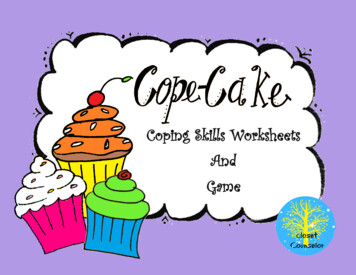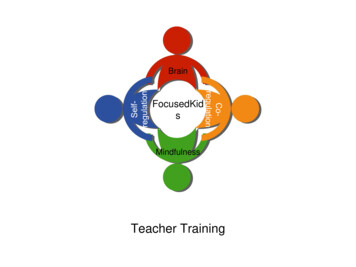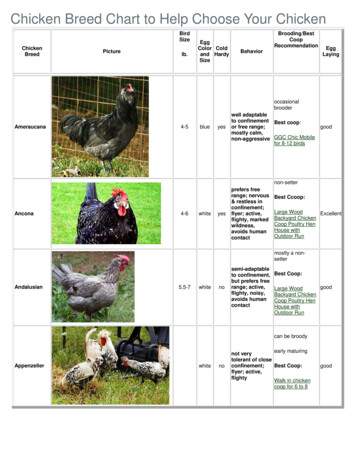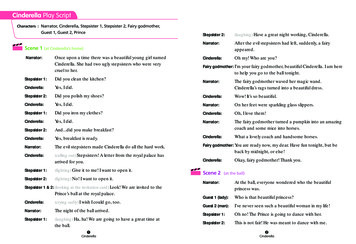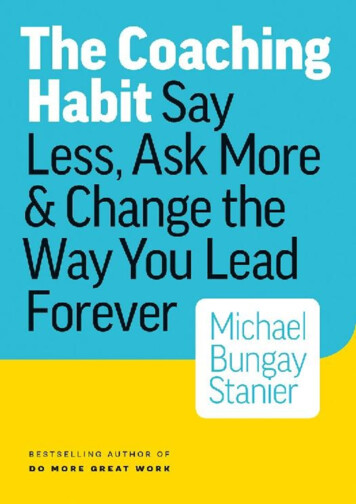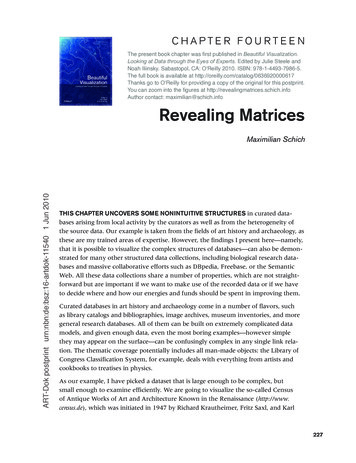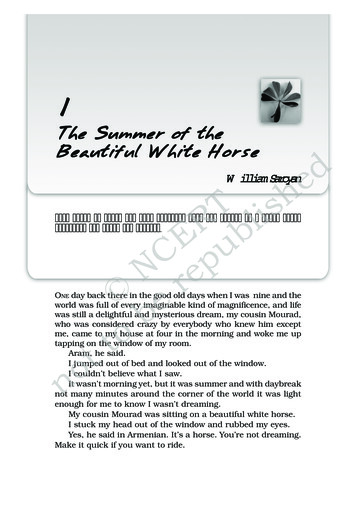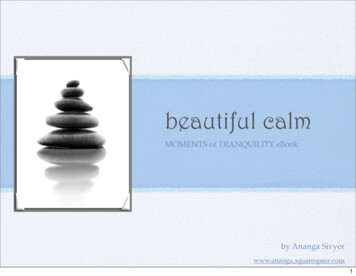
Transcription
beautiful calmMOMENTS of TRANQUILITY eBookby Ananga Sivyerwww.ananga.squarespace.com1
IntroductionHello and welcome to the world of beautiful calm. There is a place that exists deep within us all, far away from traffic,email, deadlines and cell phones. If that sounds like new age fluffy talk, it wasn’t meant to. If you ask a passingneuroscientist, he or she, will happily tell you of the benefits of relaxation for your body and your brain. And that gettingthose benefits doesn’t have to be complex or involve sitting in a cave for a few months.How many times have you felt you “should” learn to relax more. Or maybe learn to meditate? But learning doesn’tsound very inviting when you’re already busy and feeling stressed.That’s why I made this eBook and it’s accompanying audio program. I wanted to offer something that I would have likedwhen I was a stressed out commuter working in central London 20 years ago.I wanted something to help me feel calm, some way of escaping, or retreating, from all the pressure and rushing aboutmy job involved. I was lucky. I found solace, quit my job and changed my life. And now I’m able to spread some calmabout too.This eBook offers eight quick and easy ways to shrug of stress and tension and experience the relief of feeling relaxedand calm - it is my gift to you, I hope you enjoy it.spread the calm.your are invited to share this eBook with your friends, or offer it as a free gift on yourwebsite, in your newsletter etcBeautiful Calm eBook & Audio CDscopyright - 2007 Ananga Sivyer. All rights reserved.This work may be freely shared, but can not be sold, or altered in any way.2
Are You on the Journey to Snapping Point?We don't suddenly break down, grind to a halt, get seriously ill. We do it over time, day by day, bit by bit,straw by straw, until *snap* - we broke the proverbial camel's back.It seems sudden, shocking and out of the blue, but the truth is that all things manifest over time. Theyonly appear sudden if we haven't noticed what was going on in the build up to the final crescendo thatactually gets our attention.The High Price of Self-NeglectTo ignore the early warning signs is ignorance. Ignore-ance. The opposite of that ignore-ance is thesimple self-supporting act of paying (as in investing) attention. Investing in ourselves, in self-care, intaking care of the little things. In doing what they tell you to on planes. That is, put your own oxygenmask on before you try and help anyone else.Why? Because we can't help ourselves, or anyone else, if we're gasping for air. But sadly, that's exactlywhat many of us are doing. We're gasping for air, grabbing food to go, and snatching rest. We areignoring the basic self-preserving, self-supportive acts that give us longevity, health, and peace of mind.Now, more than ever, with information overload and the quick, quick, super quick, mood of how to getthings done, we are running around with the sound of ticking in ours ears and declaring that we have "notime" to eat properly, rest properly etc etc. It's not true! We have time. We have as much time as we everdid. What changed is our perception of it and our shift in values.Moments of Tranquility are about s-l-o-w-i-n-g d-o-w-n. They are about finding “me” time. A few momentsof peace and calm, to reduce stress and tension, to be free from anxiety, to escape from “shoulds” and“musts”. No matter how busy you are, you can spare 5-10 minutes to indulge yourself in some Momentsof Tranquility. For best results, you can download the guided audio files and listen to them on your PC,iPod, or MP3 player. With Moments of Tranquility it couldn’t be quicker, or easier to get calm and feelgood.3
Inviting Beautiful Calm Into Your LifePeaceful MomentsIf you've ever taken the trouble to get up before the birds and do some meditation, you'll know that thereexists a still and peaceful place, before the world starts rushing about. If you've ever taken time outduring the day to sit quietly and breathe deeply, you'll know that you can slow it all down and get back inbalance with yourself. If you've ever sat down to a home cooked meal, prepared with love, and eatenwith gratitude, you'll know how content and nourished your body and mind feel afterwards.A few minutes spent in peaceful contemplation sends signals to your body to lower its stress responsesand stop pumping adrenaline through your veins. It tells your digestive system that its OK to give its fullattention to the contents of your stomach and convert them into cell nourishing and repairing nutrientsand it tells your mind and emotions that its OK to be still, be calm and be relaxed.Baby Steps towards a Permanent Sense of TranquilityLearning something new can seem a daunting task for busy people, but taking care of yourself needn’tbe complex or time consuming. It can be as quick and easy as learning one simple breathing exercise ormeditation technique and doing it for just 10 minutes a day.We cannot afford to live in ignorance. It's too costly. To our relationships, our minds and our bodies. Whynot start investing in yourself today with a commitment to a few daily moments of peace and tranquility?You’re worth it!4
Your Breath & Your MindIf you can read this, then the chances are you don’t consider yourself a beginner at breathing. After all, you’vebeen doing it for years. But are you really breathing consciously? Or are you operating on automatic pilot andmissing out on a whole host of breath related benefits?Breath awareness can help your body detox, repair, regenerate and recover from stress. Here are somesimple secrets of how your breath can calm your mind and heal your body Influencing AutonomyBreathing is the only vital autonomic bodily function that can be consciously controlled and directed by themind. This is so for a reason; your breathing is a bridge between your body and your mind. To allow yourbreathing to remain unconscious and automatic is to exist in a realm where that bridge is obstructed.The breath is intended as a balancing device, a tuning tool that allows you conscious control of your emotions,and access to states of deep relaxation and harmony. Your breath holds the key to the door of compassionand understanding for all living beings. Why? Because it is in the moments of peace and stillness created bybreath awareness that you can get in touch with the inner you. The peaceful, calm and competent you, andthe you that can extend empathy, care and concern to others.Being able to control your breath means being able to control your mind and being able to deeply nourish,oxygenate and detox the cells and tissues of your body.“When breathing is depressed or strained, all sorts of diseases will occur. Those who wish to nurture their livesmust first learn the correct methods of controlling the breath and balancing energy. These breathing methodscan cure all ailments great and small.”from Precious Recipes by Sun ssu-mo of the Tang Dynasty5
Stress - Destroyer of Health & RelationshipsWhen you are rushing about too busy and too stressed to eat properly, breath properly etc etc you are also toobusy to connect properly with others. Over years of observation it has come to my attention that stressedpeople are not popular people. They are snappy, selfish and a strain to be around. They are missing out on thesweetness and subtleties of life. Stress robs us of the pleasures to be found in simple things in life and cancause us to drive others nuts with our ranting about little inconveniences that become mountains of selfobsessed stupidity.Stress is a personality spoiler, breathing practice nourishes personality. It may well be one of the most powerful,yet overlooked tools in the field of personal development.Deeply Does it Deep breathing is also detoxing to the internal organs as the diaphragm assists the heart by massaging theorgans as it draws down to breath deeply and then pumping blood strongly back up to the heart and lungs formore effective cleansing and re-oxygenation.Detoxing, regeneration and repair of the body are further enhanced and triggered by the parasympatheticswitch brought about by deep breathing. Slowing and deepening your breathing is a sign to your body to switchoff the “fight or flight” responses that operate when you’re under duress.The trouble with the hustle and bustle of modern life is that your body may perceive you to be alwaysexperiencing stress to some degree. If you are in the habit of breathing rapidly and shallowly, your nervoussystem may not get the message to “stand down” and you may be rapidly burning your energy reserves byliving on constant standby.That standby state keeps adrenaline coursing through your veins, puts your digestive system on hold, andcauses excess heat and acidity in the body - which are two major causes of degeneration and disease.6
Slow Your Breath and Lengthen Your LifeThe Vedas (the ancient sacred texts of India) teach that life duration is measured in breaths and that there is adirect relationship between how fast you breath and how long you live. To breath rapidly and high up in thechest squanders your vitality. It makes you gasp like a fish out of water. Slowing your breathing preserves yourvital energy and calms your spirit.A recent study in India concluded that the average volume of air inhaled can be increased by up to 50% afterjust 15 minutes of deep diaphragmatic breathing and that the average number of breaths per minute reducedfrom 15 to just 5 breaths a minute thus making breathing more efficient, energy producing, and stress reducing.How to Educate Your LungsBoth Qigong (which literally mean “energy work” or “breathing skill”) and Yoga teach a basic form ofdiaphragmatic breathing that can be learned and practised easily and without complex instruction.Daily sessions of 10 to 15 minutes are long enough to make a significant difference to your life, the addedbenefit of regular practice being that you will educate yourself to be always more mindful of your breath, or atleast to know how to stand down and recover quickly from stress and emotional upsets.7
A quick guide to deep diaphragmatic breathing Stage 1: InhalationInhale through your nose. Relax your diaphragm as you breath in and let it draw the air down deep into yourabdominal cavity (i.e. Stomach area). Allow your ribcage to relax and expand as you breath in so that yourlungs can get “topped up” right up to your collarbone area.Then press the air down into your diaphragm so that your stomach wall is pushed out.Stage 2: RetentionHold that breath! Consciously hold the breath for about 5 seconds then relax and let it out.Stage 3: ExhalationPull your stomach in and up and let the breath out in a slow steady stream through your mouth. Be sure to fullyempty your lungs.Stage 4: Empty RetentionPause for a few seconds with your lungs empty before starting again with the next complete and deepinhalation.Note: In pranayama, Yoga’s ancient system of breathing for health and longevity, it is this held empty state thatis considered the most beneficial to the body and the mind.8
Meditation 101Meditation: an altered, yet natural, stateWhat is an altered state? Simply put, it's a state that's different to your usual state of waking consciousness,and different from your sleeping state too. It's like a state between the two worlds of wakefulness and sleep,you're very relaxed, but you're awake, you can be very focused, yet you're very relaxed.Meditation produces highly beneficial alpha brain-waves that result from deep relaxation. One of the manybenefits of meditation is that it's positive effect on the nervous and immune systems of your body can staywith you for hours, unlike recreational relaxants where the body swings back into a stress aroused state assoon as their influence has worn off, the rewards of meditation are both long lasting and accumulative. Themore you meditate the better you get at it and the better you feel.Meditation: the ultimate antidote to stressStress is considered a contributing factor in up to 80% of all illness. At best it makes you irritable, unpopularand unproductive, at it's worst it makes you miserable and sick.Meditation helps soothe stress by allowing the sympathetic nervous system to stand down. The sympatheticnervous system is what fires the "fight or flight" response, but it's only designed for short-term use and iftriggered to frequently or held on-line for too long you begin to loose vital energy and immunity. Yourrelationships suffer, your work suffers and your health suffers. In short, stress equals suffering, but meditationcan quickly act as a powerful and enjoyable anti-dote and gain you entry into the pleasurable realm of therelaxation response.Research has repeatedly shown that regular practice of meditation for just 10-20 minutes a day significantlyreduces the symptoms of stress.9
Meditation 101 cont’d.If you feel you are running too hot, it's because you are immersed in the red alert energy of your sympatheticnervous system. By learning some simple meditation exercises you can douse the fire of self-destruction andget cool, calm and collected in minutes.Chinese Medicine considers the sympathetic nervous system to be yang and it's balancing counterpart - theparasympathetic nervous - system to be it's yin.The parasympathetic nervous system serves to return the body and mind to a calmly functional state whereno danger is perceived. It is a stand-down state, an "all clear" signal to your body and mind that they can relaxand get on with what they want to be doing. Meditation triggers the parasympathetic nervous system andgives you a welcome break from the adrenaline fuelled states that can be so destructive to your body.Meditation: an act of self-kindnessWhen you go on an aeroplane, the flight attendants tell you that in the event of an emergency you should putyour own oxygen mask on before trying to assist anyone else. Why? Because you're no good to yourself orothers if you're gasping for air.Here on the ground, things might be less dramatic, but the principle still applies. If you are riddled with stress,then you are (to a degree directly related to the amount of your stress) useless.If you want to care for yourself and your friends and family better there are few gifts you could give yourselfthat are as valuable as the experience of meditation.10
5 Tips for Developing a Good Meditation Practice1. Stretch Before you Sit.Stretch your body out to release tension before sitting down to meditate. If you know a yoga posture or two,like the triangle, or the warrior pose, you could try those to relax and stretch your major muscle groups.Otherwise just stretch how you feel comfortable, trying to give all your major muscles a few momentsattention and relief.You could give your arms and legs a bit of a shake too, just to make sure everything is loose and relaxedbefore you begin.It's up to you how long you invest in preparing your body, if you're short on time, even a minute spentstretching can free you of a lot of tension.2. Practice DailyFor maximum benefit from meditation, make it a habit. Set aside a time each day for your quiet time.Recommended times for meditation are the peaceful morning hours before the world gets up and startsrushing about, and twilight.By making meditation a daily event in your life you will gain numerous benefits, not just from the practiceitself, but from the simple act of commitment and awareness to meditation being a part of your life and yourattunement to beneficial times of regular practice.Regularity is one of yoga and ayurveda's recommendations for a strong and peaceful mind.11
3. Setting the SceneIt's not always easy to enter into a meditative state, especially when meditating later in the day when yourmind has picked up the pace. Or when you know you have other things that need your attention too.To slide into a meditative state more easily you could use guided techniques where someone already in thatstate talks you through, or you could simply prepare yourself with a prayer, or statement of intention, that thenext few minutes can be spent in peaceful contemplation and that everything else can wait.You could breathe deeply for a minute or two, emptying your lungs with some push from your diaphragm anddropping your shoulders as you settle down to begin.4. Don't Feel Pressured by TimeMeditation should be a pleasant and welcome experience, once you get into a routine, you may find yourmind hankering for those moments of peace. But if you feel uncomfortable committing to 15-20 minutesessions, allow yourself the freedom to practice regularly and briefly. It's better to invest 5-10 minutes everyday in meditation, that to sporadically enter into 30 minute meditation marathons. Remember the benefits ofregularity, and focus on developing a self-healing habit that's easy for you to maintain.12
5. Floating ThoughtsMeditators often refer to restless mind as the "monkey mind", In India's timeless classic, the Bhagavad Gita,Lord Krishna states that: "controlling the mind is more difficult than controlling the wind".It's practically impossible to think of nothing, the secret of meditation is to let thoughts float by without givingthem your attention. Your mind will wander, that's OK, just keep bringing it back to awareness of your breath,try focusing on the sounds of your breath as it enters and leaves your body. Practice keeping still and quietand, though you can't silence your thoughts, you can hush them for a while and slow the swirling winds ofyour mind into a contemplative breeze for just a few minutes.Get beautifully calm today.beautiful calm - eight guided meditation experiences (asfeatured in this eBook) PLUS 8 relaxing musical compositionsavailable as a 2CD audio set or as instant MP3 downloads .CD1: 8 step-by-step guided relaxation & meditation experiences. Withbacking music designed to enhance the feeling of well-being you will enjoywhen you listen to each session.CD2: 8 compositions for relaxation, meditation or daydreaming. Let tensiondrain away as the sounds of bamboo flutes, tibetan bowls, and othertraditional meditative instruments transport you to a place of beautifulcalm.tell me more.13
9 Ways to Find Calm & Tranquility New Beginnings in BreathingBeginners Buddhist MeditationFive Finger QiGongBody Gratitude MeditationCounting BreathsHealing Energy MeditationThe Grounding TechniqueThe Relaxing BreathMindfulness Meditationthese meditations are also available as guided exercises with soothing backgroundmusic in the beautiful calm CD set or as instant access MP3 downloads.“me time.”14
New Beginnings in BreathingNew beginnings in breathing is a simple exercise designed to help you learn to breathe slowly and deeply, downinto your stomach area. This simple technique is effective in reducing stress and anxiety, and can be practisedanywhere and anytime you choose.Here's how to do it:- make yourself comfortable either sitting or standing. Drop your shoulders and relax your mouth.- place your right hand over your navel - now take a slow deep breath in through your nose and try to make thehand resting on your stomach push out slightly as you draw the breathe down into your body.- hold the breath for a couple of seconds- now release it through your mouth in a steady stream, until your lungs are completely empty- now breath in again, deeply filling your lungs down into your abdomen and feel your right hand being pushedout again- and hold that breath for a couple of seconds- then fully release it and feel your hand sink back in againNext time you breath in focus on your breath and hear the sound of it filling your lungs and then leaving yourbody. You might notice that the sound of your incoming breath is different to the sound of it leaving your body. Byfocusing on the sounds of your breath you are turning this exercise into a mindfulness meditationKeep breathing slowly and deeply for the next five minutes, be sure to bring the breath down deeply into yourbody and release each breath fully, listen to the sounds of your breath and let all other thoughts drift away.15
Beginners Buddhist MeditationFind a private and comfortable place to sit, somewhere where you won't be disturbed for the next 10 minutes.When you're ready, drop your shoulders, close your eyes, and begin to focus on your breathing. Focus on yourbreath as it enters and leaves your nose, this is your point of focus for this meditation, and this is where yourattention should stay.If your mind wanders, just keep drawing it back to this point. Take some deep breaths and allow your stomachto fill out with each inhalation and fall back in with each breath out.Let any thoughts just wander through your mind and out again, don't try to push them away, or focus on them,just let them drift past.Keep drawing your attention back to your breathing, back to the point at the tip of your nose, where each newbreath enters your body.Continue like this breathing deeply and focused on your breath for the next few minutes.Beyond anything else, listen to yourself.You are meant to discover reality from inside and to direct your life in this way.As you begin to live according to your own guidance and your own daring,everything changes completely.B. Marciniak16
Five Finger QiGongFive finger qigong is an exercise often used for calming the mind and easing anxiety.To begin sit down in a comfortable position and make an o shaped ring with the thumb and index finger of bothyour hands (see image below).Rest your hands lightly on your lap, with your palms facing upwards and breathe deeply becoming aware ofthe cooling sensation as the air enters your nose. Remain like this breathing calmly for a few moments.Focus on your breath and the slightest, lightest pressure between your thumbs and index fingers.Now move your thumbs to connect lightly with your middle fingers and continue to breath slowly and deeply forthe next minute.When a minute has passed move your thumbs lightly onto your ring fingers and keep breathing deeply andcalmly for the next few moments.And when another minute has passed, move your thumbs to make contact with you little fingers - keep yourposture and your breathing relaxed and remain, breathing deeply and calmly, for another minuteWhen practicing meditation, though you may encounter difficulties, let notyour mind be anxious.When the moon has been eclipsed will it not freely shine again?Tishan17
Body Gratitude MeditationLet your eyes gently close, and draw a deep breath down into the bottom of your belly. And take a few minutesto meditate with gratitude and appreciation on your body.Your body is an army of a million cells that act as your subordinates, every day doing your conscious andunconscious bidding, digesting your food, nourishing your brain, oxygenating your blood, removing wastes andtoxins from your body, without direct request and often without appreciation.Settle down now and take a few moments to appreciate the miracle that is your body. Your beating heart, yourbreathing lungs, your wonderful brain, better than any computer every made by man. And your muscles andbones, that hold you up and that you can direct to move you wherever you want to go.Breath deeply down into your lungs and take a moment to melt away any tension, allow yourself to sink backinto your resting place and let your jaw go slack. Let your shoulders drop and relax.Allow yourself and your body to relax now from all the hard work, all the rushing around, and all the things youhave to do together every day.In this time you can say thank you to your body, as you know it's serving you the best it can.This meditation is included in the Beautiful Calm meditation set - it is spoken as a gentlyguided exercise so you can get maximum benefit and relaxation without having to read orremember what to do.Accompanied by traditional Celtic instruments, this session is a very calming experience.You can get your copy by instant download, or on CD here.18
Counting BreathsSit in a comfortable position with your spine straight and a slight smile on your lips to relax your face. Closeyour eyes and rest your tongue against the roof of your mouth as if you were going to pronounce the sound ofthe letter "l".Now take a few deep breaths, drop your shoulders and concentrate on breathing steadily and calmly.To begin counting breaths count one to yourself as you exhale, and the next time you exhale count two, on thenext exhalation count three, and keep counting as you breathe out until you have counted five outwardbreaths.Then begin a new cycle. Starting again when you next breath out count one, try and breath deeply andsteadily, slowing your breath gradually as you become more relaxed and keep counting until you have countedfive more exhalations.And then begin again. Keep breathing and counting until you have completed five cycles of five exhalations.Try and keep your attention on counting and breathing, and as you do you can enter a state of mindfulnessand awareness of the present, which is greatly beneficial to your peace of mind and to your immune systemtoo.Don’t worry if you loose count, just begin again at number one. Loosing count means your mind wandered onto other thoughts, with practice you can learn to keep bringing it back to counting and letting any otherthoughts wander through your mind without it chasing after them.19
Healing Energy MeditationStand with your feet about shoulder width apart, slightly bend your knees, keeping your spine straight, andallow yourself to sink down into the ground a little. Shake your arms and hands and release any tension fromyour arms and shoulders.Now cup your hands but keep your fingers slightly apart, bring your hands in front of you level with your navelhave your left hand cupped facing palm upwards as if it was holding an imaginary ball and place your righthand on top of that imaginary ball with it's palm facing downwards so the ball is contained in the curved spaceof your two cupped palms, with your left hand at the bottom and your right hand resting on the top.Keeping your knees soft, your spine straight and your breathing deep and steady, focus your attention on thatimaginary ball and begin to move your hands around it, rotating it in front of you. As you breathe you canimagine that ball filling with vital energy.Keep moving your hands around, breathe deeply and focus your attention on the ball of healing energy, witheach breath in imagine filling the ball with more and more vital energy, and soon you might notice a slight warmresistance between your hands.Keep breathing deeply and building the energy in the ball as you move your hands around it, focus on the ball,focus on it's warmth, on the resistance between your hands and on your deep, steady breath.Now bring your two hands around the ball until they are resting side by side in front of your navel, with yourlittle fingers next to each other and your palms facing upwards so the ball is sitting on top of your hands.Gradually raise your hands up the front of your body, keeping them parallel with the floor, bring them up to yourface lifting the ball past the front of your face, feeling it's warmth, and on up to the top of your head, and let itgo over the top of your head.20
Healing Energy Meditation continued.Stretch your arms out and up to the sky so that you are forming the shape of the letter “Y” and as you releasethat ball feel it melting into the top of your head and sinking down through your body, nourishing you andreplenishing your energy as it moves down your body through your legs, and feet, and into the ground.Take a deep breath, and bring the palms of your hands together, bring them down the front of your face, withyour palms touching as if in prayer, and bring them down to your chest and keep them moving down the frontof your body allowing them to naturally part as they reach your waist and now bring them to rest at your side.Take a few more deep, slow breaths, give your whole body a shake, and enjoy feeling relaxed, energised,centred and calm.“The wish for healing has ever been the half of health”Hippolytus (Christian martyr, 170-235)21
The Grounding TechniqueThe Grounding Technique is a great way to calm the chatter of your mind. It also improves co-ordinationand increases mental clarity and alertness.Here’s how to do it:Bend you knees slightly and place your tongue on the roof of your mouth behind your top teeth, shrug yourshoulders and shake your arms for a few moments to free up any tension.Now focus on your feet and imagine them sinking down into the ground that supports them, imagine themfeeling rooted deep into the earth.Place the fingertips of your left hand beneath your lower lip in the centre of your chin and place the heel of yourright hand over your navel with the fingertips of that hand pointing down towards the ground, breath deeply andgradually slow your breathing down.If you want to, you can imagine the colour red at the base of your spine, deep earthy red. Stay like this andhold your hands on these energy points for the next few moments.Now push your feet down into the floor and switch hands, breath deeply and allow yourself to let any tensiongo from your neck and shoulders. Remain like this for a few moments.Then push your feet down into the floor and switch hands, focus on your feet and imagine them being deeplyrooted into the earth, and remain again for a few more moments, breathing deeply and steadily down into yourstomach.“In dwelling, live close to the ground. In thinking, keep to the simple. Inconflict, be fair and generous. In governing, don't try to control. In work,do what you enjoy. In family life, be completely present.”Tao Te Ching22
The Relaxing BreathThe relaxing breath is sometimes called the 4:7:8 breath because of the counting pattern involved, it's a verysimple and calming exercise, and once you've practised it here
simple secrets of how your breath can calm your mind and heal your body Influencing Autonomy Breathing is the only vital autonomic bodily function that can be consciously controlled and directed by the mind. This is so for a reason; your breathing i
